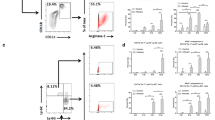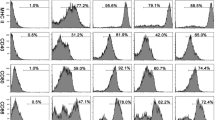Abstract
As already shown, some inducers of the differentiation of promyelocytic cells along the granulocytic pathway, such as dimethylsulphoxide (DMSO) or all-trans retinoic acid, can enhance propagation of granulocytic ehrlichiae in HL-60 cell cultures. This study was conducted to prove whether sodium valproate, a salt of di-n-propylacetic acid (VPA) known to trigger cellular differentiation in several solid and hematopoietic malignancies is similarly efficient in ehrlichial cultures. Two cell lines derived from HL-60, that is, low-passage undifferentiated HL-60 (HL-60F) and high-passage HL-60 spontaneously differentiated towards monocytic phenotype (HL-60J) were grown in RPMI 1640 medium supplemented with 10% FBS. The respective HL-60F and HL-60J IC50-values for NaVPA were estimated to be 0.8 and 2.2 mM under these culture conditions; to stimulate the differentiation, the respective doses of 0.3 and 1.2 mM were then applied. When the NaVPA-treated cells of both lines were challenged with an ehrlichial laboratory strain (HGE), maintained in splenectomized NMRI mice, the respective 1–2 and ≤0.1% primary infection rates in HL-60F and HL-60J cultures were observed 3 days post-inoculation. In comparison, only rare (≤0.1%) infected HL-60F and no infected HL-60J cells were recorded under the same experimental conditions in untreated control cultures. HGE continuously propagated in NaVPA-supplemented HL-60F cultures remained infectious to mice at least up to the 95th passage (12 months). NaVPA can thus facilitated continuous propagation of granulocytic ehrlichiae in cell cultures without a substantial loss of infectiveness.
Similar content being viewed by others
References
Bakken, J.S. et al. 1994. Human granulocytic ehrlichiosis in the upper Midwest United States: a new species emerging? JAMA 272: 212-218.
Cinatl Jr., J. et al. 1996. Antitumor activity of sodium valproate in cultures of human neuroblastoma cells. Anti-Cancer Drugs 7: 766-773.
Cotariu, D. et al. 1992. Inhibition of human red blood cell glutathione reductase by valproic acid. Biochem. Pharmacol. 43: 425-429.
Dumler, J.S. et al. 2001. Reorganization of genera in the families Rickettsiaceae and Anaplasmataceae in the order Rickettsiales: unification of some species of Ehrlichia with Anaplasma, Cowdria with Ehrlichia and Ehrlichia with Neorickettsia, description of six new species combinations and designation of Ehrlichia equi and 'HGE agent' as subjective synonyms of Ehrlichia phagocytophila. Int. J. Syst. Evol. Microbiol. 51: 2145-2165.
Goodman, J.L. et al. 1996. Direct cultivation of the causative agent of human granulocytic ehrlichiosis. N. Engl. J. Med. 334: 209-215.
Heimer, R. et al. 1997. Propagation of granulocytic Ehrlichia spp. from human and equine sources in HL-60 cells induced to differentiate into functional granulocytes. J. Clin. Microbiol. 35: 923-927.
Kawagoe, R. et al. 2002. Valproic acid induces apoptosis in human leukemia cells by stimulating both caspase-dependent and-independent apoptotic signaling pathways. Leuk. Res. 26: 495-502.
Kishi, T. et al. 1994. Bone marrow suppression induced by high dose valproic acid. Arch. Dis. Child. 71: 153-155.
Klein, M.B. et al. 1997. Primary bone marrow progenitors of both granulocytic and monocytic lineages are susceptible to infection with the agent of human granulocytic ehrlichiosis. J. Inf. Dis. 176: 1405-1409.
Klein, M.B. et al. 1998. Monocytic differentiation inhibits infection and granulocytic differentiation potentiates infection by the agent of human granulocytic ehrlichiosis. Inf. Immun. 66: 3410-3415.
Kunz-Simon, G. and Obert, G. 1995. Sodium valproate, an anticonvulsant drug, stimulates human cytomegalovirus replication. J. Gen. Virol. 76: 1409-1415.
Munderloh, U.G. et al. 1996. Isolation of the equine granulocytic ehrlichiosis agent, Ehrlichia equi, in tick cell culture. J. Clin. Microbiol. 34: 664-670.
Petrovec, M. et al. 1997. Human disease in Europe caused by a granulocytic Ehrlichia species. J. Clin. Microbiol. 35: 1556-1559.
Simon, G. et al. 1994. Valproic acid reduces the intracellular level of glutathione and stimulates human immunodeficiency virus. Chem. Biol. Interact. 91: 111-121.
Tittle, T.V. et al. 1992. Segregation of the growth slowing effects of valproic acid from phenytoin and carbamazepine on lymphoid tumor cells. Life Sci. 50: 79-83.
Woldehiwet, Z. and Scott, G.R. 1982. In vitro propagation of Cytoecetes phagocytophila, the causative agent of tick-borne fever. Vet. Microbiol. 7: 127-133.
Author information
Authors and Affiliations
Rights and permissions
About this article
Cite this article
Zeman, P., Cinatl, J. & Kabickova, H. Sodium Valproate Facilitates the Propagation of Granulocytic Ehrlichiae (Anaplasma phagocytophilum) in HL-60 Cells. Exp Appl Acarol 28, 203–208 (2002). https://doi.org/10.1023/A:1025398432754
Issue Date:
DOI: https://doi.org/10.1023/A:1025398432754




